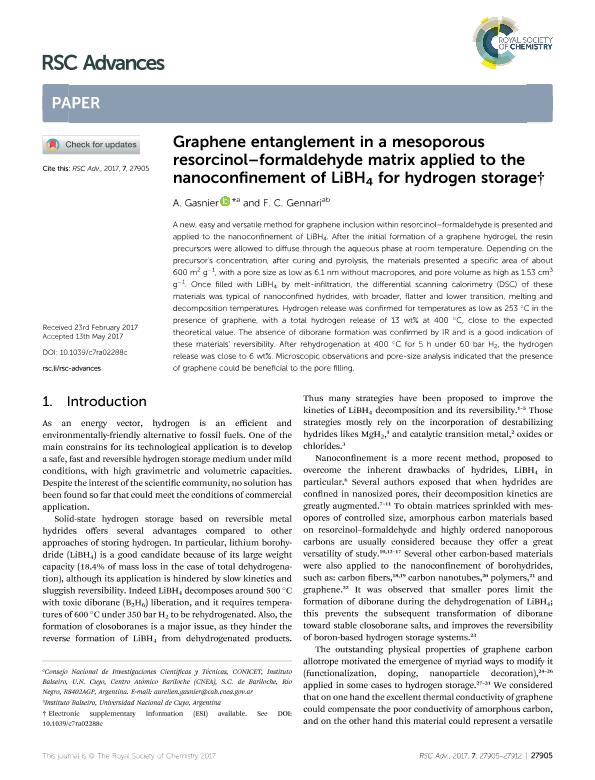Artículo
Graphene entanglement in a mesoporous resorcinol-formaldehyde matrix applied to the nanoconfinement of LiBH4 for hydrogen storage
Fecha de publicación:
05/2017
Editorial:
Royal Society of Chemistry
Revista:
RSC Advances
ISSN:
2046-2069
Idioma:
Inglés
Tipo de recurso:
Artículo publicado
Clasificación temática:
Resumen
A new, easy and versatile method for graphene inclusion within resorcinol-formaldehyde is presented and applied to the nanoconfinement of LiBH4. After the initial formation of a graphene hydrogel, the resin precursors were allowed to diffuse through the aqueous phase at room temperature. Depending on the precursor's concentration, after curing and pyrolysis, the materials presented a specific area of about 600 m2 g-1, with a pore size as low as 6.1 nm without macropores, and pore volume as high as 1.53 cm3 g-1. Once filled with LiBH4 by melt-infiltration, the differential scanning calorimetry (DSC) of these materials was typical of nanoconfined hydrides, with broader, flatter and lower transition, melting and decomposition temperatures. Hydrogen release was confirmed for temperatures as low as 253 °C in the presence of graphene, with a total hydrogen release of 13 wt% at 400 °C, close to the expected theoretical value. The absence of diborane formation was confirmed by IR and is a good indication of these materials' reversibility. After rehydrogenation at 400 °C for 5 h under 60 bar H2, the hydrogen release was close to 6 wt%. Microscopic observations and pore-size analysis indicated that the presence of graphene could be beneficial to the pore filling.
Palabras clave:
Graphene
,
Hydrogen Storage
,
Nanoconfinement
Archivos asociados
Licencia
Identificadores
Colecciones
Articulos(CCT - PATAGONIA NORTE)
Articulos de CTRO.CIENTIFICO TECNOL.CONICET - PATAGONIA NORTE
Articulos de CTRO.CIENTIFICO TECNOL.CONICET - PATAGONIA NORTE
Citación
Gasnier, Aurelien; Gennari, Fabiana Cristina; Graphene entanglement in a mesoporous resorcinol-formaldehyde matrix applied to the nanoconfinement of LiBH4 for hydrogen storage; Royal Society of Chemistry; RSC Advances; 7; 45; 5-2017; 27905-27912
Compartir
Altmétricas




